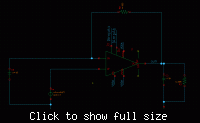walker5678
Full Member level 3

op amp dc bias phase shift
I encountered a strange thing when analyzing the opamp's AC characteristic, that the AC phase plot start from -180 degree at DC frequency, and begin to increase to -170, -160... etc.
And the pz analysis showes there is a RHP pole.
But when decrease the supply voltage, the AC plot returns to normal.
The OP amp's circuit has been proved on other process, and i just want to migrate it to another process.
Any one meet the similar thing?
Thanks
I encountered a strange thing when analyzing the opamp's AC characteristic, that the AC phase plot start from -180 degree at DC frequency, and begin to increase to -170, -160... etc.
And the pz analysis showes there is a RHP pole.
But when decrease the supply voltage, the AC plot returns to normal.
The OP amp's circuit has been proved on other process, and i just want to migrate it to another process.
Any one meet the similar thing?
Thanks











